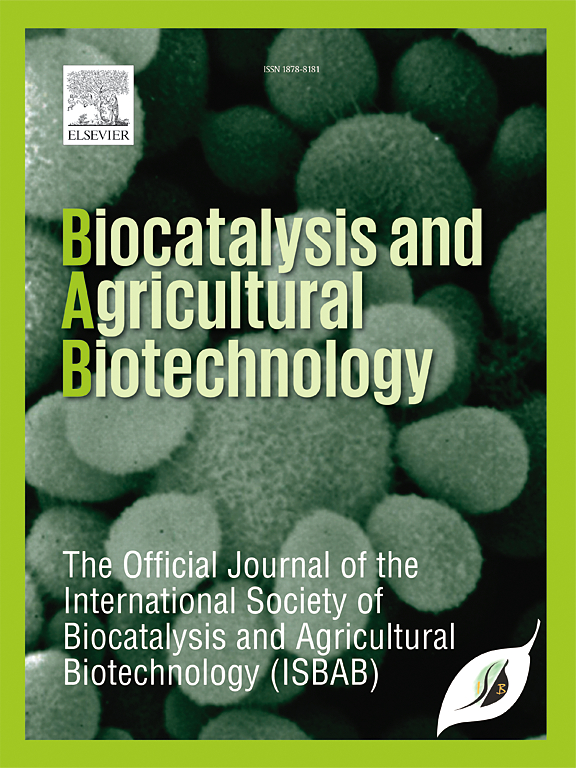Antibacterial and cytotoxic activities of a newly green synthesized ZnO/Se nanocomposite combined with Washingtonia robusta H. Wendl fruit extract
IF 3.4
Q2 BIOTECHNOLOGY & APPLIED MICROBIOLOGY
引用次数: 0
Abstract
Bacterial infection is one of the most frequent and crucial issues worldwide. It can prolong the use of self-medication and the healing period or it may be associated with treatment failure that leads to additional hospitalization, increased costs of care and mortality. Novelties and discoveries are directed toward supporting human health and maintaining the environment through innovative synthesis techniques that are modernized. The current study provides a simple and cost-effective approach for the green synthesis of a zinc oxide/selenium nanocomposite (ZnO/Se NC) combined with Washingtonia robusta H. Wendl fruit extract as a new antibacterial agent. The W. robusta H. Wendl fruit extract was subjected to fractionation using four different solvents (n-hexane, chloroform, ethyl acetate, and methanol) based on the solvent-solvent extraction method. All fractions were tested for their antibacterial activity against some Gram-positive and Gram-negative bacteria. The methanolic fraction, which exhibited the highest antibacterial potential, was analyzed for its bioactive compounds using gas chromatography-mass spectrometry (GC‒MS). It contains 12 different biochemical compounds, including heptasiloxane (54.19%), octasiloxane (10.59%), oleic acid (9.83%), decanoic acid (3.97%), 1,2,3-propanetriol,1-acetate (3.37%), and hexadecanoic acid (3.18%) as the main constituents. The methanolic fraction was used to synthesize the ZnO/Se NC. Ultraviolet–visible spectroscopy (UV–Vis), X-ray diffraction (XRD), Fourier transform infrared spectroscopy (FTIR), zeta analysis, and transmission electron microscopy (TEM) were applied to characterize the ZnO/Se NC. The antibacterial activity of ZnO/Se NC combined with methanolic W. robusta H. Wendl fruit fraction was investigated against Escherichia coli ATCC25922, Pseudomonas aeruginosa ATCC27853, Staphylococcus aureus ATCC25923 and Bacillus cereus ATCC6633 and compared to that of ZnO NPs and ciprofloxacin as a standard drug using the agar well diffusion method, minimum inhibition concentration (MIC), and minimum bactericidal concentration (MBC). The ZnO/Se NC exhibited a higher antibacterial activity than ciprofloxacin, with average inhibition zones of 43 ± 0, 47 ± 0.03, 39 ± 0.06, and 36 ± 0.18 mm against E. coli, P. aeruginosa, B. cereus, and S. aureus, respectively. The MICs of ZnO/Se NC were 15 and 25 μg/ml against P. aeruginosa and Bacillus cereus, while ciprofloxacin had MICs of 30 and 45 μg/ml against the same bacteria. TEM ultrastructural studies showed severe malformations and morphological changes in ZnO/Se NC-treated bacteria compared to those treated with ZnO-, W. robusta H. Wendl fruit extract and untreated bacteria. Cytotoxicity tests on the Vero cell line indicated that ZnO/Se NC had low toxicity (CC50 = 162.02 ± 3.14 μg/ml). This study presents an effective alternative nanomedicine for treating various human and animal pathogenic bacteria using a combination of W. robusta H. Wendl fruit extract and ZnO/Se NC.

求助全文
约1分钟内获得全文
求助全文
来源期刊

Biocatalysis and agricultural biotechnology
Agricultural and Biological Sciences-Agronomy and Crop Science
CiteScore
7.70
自引率
2.50%
发文量
308
审稿时长
48 days
期刊介绍:
Biocatalysis and Agricultural Biotechnology is the official journal of the International Society of Biocatalysis and Agricultural Biotechnology (ISBAB). The journal publishes high quality articles especially in the science and technology of biocatalysis, bioprocesses, agricultural biotechnology, biomedical biotechnology, and, if appropriate, from other related areas of biotechnology. The journal will publish peer-reviewed basic and applied research papers, authoritative reviews, and feature articles. The scope of the journal encompasses the research, industrial, and commercial aspects of biotechnology, including the areas of: biocatalysis; bioprocesses; food and agriculture; genetic engineering; molecular biology; healthcare and pharmaceuticals; biofuels; genomics; nanotechnology; environment and biodiversity; and bioremediation.
 求助内容:
求助内容: 应助结果提醒方式:
应助结果提醒方式:


